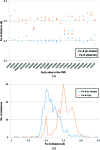CheckMyMetal: a macromolecular metal-binding validation tool
- PMID: 28291757
- PMCID: PMC5349434
- DOI: 10.1107/S2059798317001061
CheckMyMetal: a macromolecular metal-binding validation tool
Abstract
Metals are essential in many biological processes, and metal ions are modeled in roughly 40% of the macromolecular structures in the Protein Data Bank (PDB). However, a significant fraction of these structures contain poorly modeled metal-binding sites. CheckMyMetal (CMM) is an easy-to-use metal-binding site validation server for macromolecules that is freely available at http://csgid.org/csgid/metal_sites. The CMM server can detect incorrect metal assignments as well as geometrical and other irregularities in the metal-binding sites. Guidelines for metal-site modeling and validation in macromolecules are illustrated by several practical examples grouped by the type of metal. These examples show CMM users (and crystallographers in general) problems they may encounter during the modeling of a specific metal ion.
Keywords: CheckMyMetal; coordination geometry; metal-binding environment; validation.
Figures




Similar articles
-
Validation of metal-binding sites in macromolecular structures with the CheckMyMetal web server.Nat Protoc. 2014 Jan;9(1):156-70. doi: 10.1038/nprot.2013.172. Epub 2013 Dec 19. Nat Protoc. 2014. PMID: 24356774 Free PMC article.
-
CMM-An enhanced platform for interactive validation of metal binding sites.Protein Sci. 2023 Jan;32(1):e4525. doi: 10.1002/pro.4525. Protein Sci. 2023. PMID: 36464767 Free PMC article.
-
CheckMyMetal (CMM): validating metal-binding sites in X-ray and cryo-EM data.IUCrJ. 2024 Sep 1;11(Pt 5):871-877. doi: 10.1107/S2052252524007073. IUCrJ. 2024. PMID: 39141478 Free PMC article.
-
Can the propensity of protein crystallization be increased by using systematic screening with metals?Protein Sci. 2017 Sep;26(9):1704-1713. doi: 10.1002/pro.3214. Epub 2017 Jun 29. Protein Sci. 2017. PMID: 28643473 Free PMC article. Review.
-
Protein Data Bank (PDB): The Single Global Macromolecular Structure Archive.Methods Mol Biol. 2017;1607:627-641. doi: 10.1007/978-1-4939-7000-1_26. Methods Mol Biol. 2017. PMID: 28573592 Free PMC article. Review.
Cited by
-
Room-Temperature Structure of Xylitol-Bound Glucose Isomerase by Serial Crystallography: Xylitol Binding in the M1 Site Induces Release of Metal Bound in the M2 Site.Int J Mol Sci. 2021 Apr 9;22(8):3892. doi: 10.3390/ijms22083892. Int J Mol Sci. 2021. PMID: 33918749 Free PMC article.
-
The protein scaffold calibrates metal specificity and activation in MerR sensors.Microb Biotechnol. 2022 Dec;15(12):2992-3002. doi: 10.1111/1751-7915.14151. Epub 2022 Sep 22. Microb Biotechnol. 2022. PMID: 36134649 Free PMC article.
-
Structural and biochemical characterisation of a novel alginate lyase from Paenibacillus sp. str. FPU-7.Sci Rep. 2019 Oct 16;9(1):14870. doi: 10.1038/s41598-019-51006-1. Sci Rep. 2019. PMID: 31619701 Free PMC article.
-
Crystal structure of Methanococcus jannaschii dihydroorotase.Proteins. 2023 Jan;91(1):91-98. doi: 10.1002/prot.26412. Epub 2022 Aug 24. Proteins. 2023. PMID: 35978488 Free PMC article.
-
Neutron and X-ray crystal structures of Lactobacillus brevis alcohol dehydrogenase reveal new insights into hydrogen-bonding pathways.Acta Crystallogr F Struct Biol Commun. 2018 Dec 1;74(Pt 12):754-764. doi: 10.1107/S2053230X18015273. Epub 2018 Nov 26. Acta Crystallogr F Struct Biol Commun. 2018. PMID: 30511668 Free PMC article.
References
Publication types
MeSH terms
Substances
Grants and funding
LinkOut - more resources
Full Text Sources
Other Literature Sources

